|
 Camarophyllus aurantiopallens Camarophyllus aurantiopallens
SynonymsHygrocybe aurantiopallens
Hygrophorus aurantius
BiostatusPresent in region - Indigenous. Non endemic
Images (click to enlarge)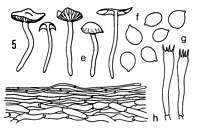
Caption: Camarophyllus aurantiopallens Hk (type) e. carpophores. - f. spores. – g. basidia. - h. cuticle | 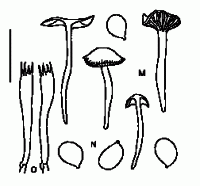
Caption: Fig. 25 Camarophyllus aurantiopallens Horak. (M-O: PDD 27088,
type) M. basidiomes. N. spores. O. basidia | 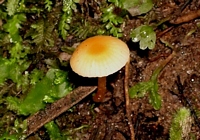
Caption: FUNNZ photo
Owner: J.A. Cooper | 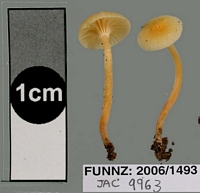
Caption: FUNNZ photo
Owner: J.A. Cooper | 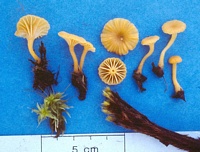
Owner: Karl Soop | 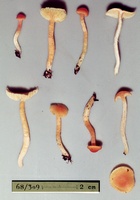
Caption: ZT68-309, Holotype
Owner: E. Horak: © Creative Commons Attribution-Noncommercial 3.0 New Zealand | 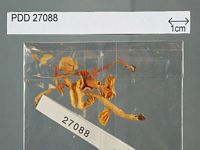
Caption: Dried type specimen
Owner: Herb PDD | 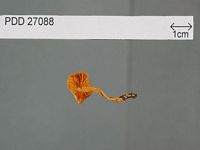
Caption: Dried type specimen
Owner: Herb PDD | 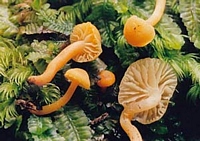
Caption: Camarophyllus aurantiopallens
Owner: Kaimai Bush | 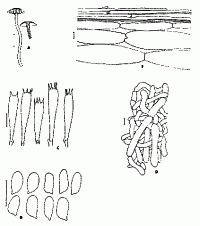
Caption: Fig. 2. Hygrocybe aurantiopallens. (A) habit (UNSW 83/987) (B) spores (UNSW 84/539)
(C) basidia (84/539) (D) hymenophoral trama (UNSW 84/539) (E) pileipellis (UNSW 83/948) | 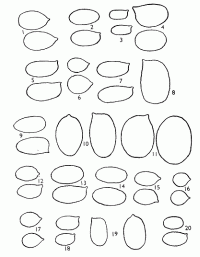
Caption: Spores X 2000 1. Hygrophorus salmonipes 2; H. elsae; 3, H .julietae; 4, H. variabilis; 5, H. lilaceo-lamelllatus; 6, H. muritaiensis; 7, H. keithgeorgei; 8, H. pseudococcineus; 9, H. rubro-carnosus; 10, H. miniceps; 11, H. procerus; 12, H. multic | 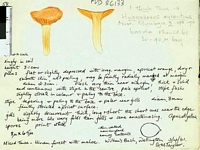
Caption: Watercolour
Owner: G.M. Taylor | |
Article: Horak, E. (1990). Monograph of the New Zealand Hygrophoraceae (Agaricales). New Zealand Journal of Botany 28(3): 255-306 (http://www.rsnz.org/publish/abstracts.php).
Description: Pileus -20 mm, hemispherical to convex becoming expanded with upturned margin;
brilliant orange to apricot, red tints absent; dry, glabrous to minutely fibrillose,
not hygrophanous, scarcely striate at margin. - Lamellae 8-10 (1 -1) broadly
adnate-decurrent to arcuate, occasionally anastomosing,. pale orange, edges
concolorous, entire. - Stipe 20-40 x 1.5-3 (-4) mm, cylindrical, equal to subfusoid;
concolorous with pileus or paler; dry, glabrous to innately fibrillose, solid
becoming fistulose, single; or caespitose. - Context pale orange. - Odour and
taste not distinctive. - Chemical reactions on pileus: KOH - negative.
Spores 4.5-5.5 x 4-5um, globose to subglobose or obovoid. - Basidia 30-35 x
5-6um, 4-spored. - Cystidia absent. - Pileipellis a cutis of interwoven, cylindrical
hyphae (2-7 um diam.), membrane subgelatinised, encrusted with pigment; clamp
connections present (Pl. 1, Fig. 5)
Habitat: ECOLOGY: Scattered; saprobic on soil under Leptospermum (and Nothofagus).
April-July.
Distribution: DISTRIBUTION: NZ (N, W). - ?Jamaica (type of H. aurantius); ?Japan.
Article: Horak, E. (1973). Fungi Agaricini Novazelandiae I-V. Beihefte zur Nova Hedwigia 43: 200 p.
Description: Pileus 10-20 mm diam., hemispherical or convex when young becoming expanded or even concave, deep orange to apricot yellow (like Mycena fibula [Fries]), darker at the centre, dry, glabrous, slightly striate at the margin. Lamellae broadly adnate to subdecurrent, light orange, frequently connected by anastomoses at the bottom, close, gill edge concolorous. Stipe 20-40 x 2-4 mm, fusoid or rarely cylindric, concolorous with pileus, dry, glabrous, fistulose, often curved. Context orange, not waxy. Taste and odor not distinctive. Chemical reactions on Pileus: KOH, HCl- negative.
Spores 4.5-5.5 x 4-5 µm, subglobose to ovoid, smooth, inamyloid. Basidia 30-35 x 5-6 µm, 4-spored. Cystidia lacking. Gill trama interwoven. Cuticle a cutis of repent, irregularly interwoven, cylindric, not gelatinized hyphae (2-7 µm diam.). Clamp connections present.
Habitat: Amongst mosses under Leptospermum scoparium (and Nothofagus cliffortioides). New Zealand.
Article: Young, A.M.; Wood, A.E. (1997). Studies on the Hygrophoraceae (Fungi, Homobasidiomycetes, Agaricales) of Australia. Australian Systematic Botany 10(6): 911-1030.
Description: Pileus (6)10-20 mm, convex (occasionally slightly umbonate), expanding to plano-convex;
smooth, dry, apricot-yellow to light orange (9J7-9I11, M&P), usually darker at the centre, all
parts fading with age; red tints completely absent; a little pellucid striate if moist, especially
towards the margins; margins usually slightly crenulate, especially when young. Lamellae
adnate-arcuate to usually subdecurrent; occasionally anastomosing; not especially thick,
widely spaced to distant, very frequently connected by veins on the undersurface of the
pileus; pallid apricot or pileus tinted, margins concolorous. Stipe 17-44 x 1.5-3.5 mm,
cylindrical but often tapers towards the base, smooth, dry, hollow, pale apricot-yellow to
similar to pileus but paler at the base to near white.
Spores (3.5)4.0-6.5 x 3.5-4.5(5.0) µm, mean 5.2 x 4.2 pm, Q: 1.0-1.6, mean Q: 1.2-1.3,
mostly subglobose but occasionally sublacrymoid, smooth, hyaline, non-amyloid. Basidia 30-41(42.5) x 4.5-7(8) µm,
mean 34 x 6 µm, Q: 4.4-7.5, mean Q: 5.7, 4-spored (occasional 2-spored forms exist, see discussion below),
clamped, sometimes with medallion clamps. R:
6.5. Cystidia absent. Hymenophoral trama subregular to irregular, composed of hyaline, thin-walled,
septate, semi-inflated, at least partially interwoven hyphae 20-90(120) x 3-12(15) µm,
frequently constricted at the septa and often with medallion clamps. Pileipellis a cutis, (often
some hyphae partially gelatinise to give the appearance of an ixocutis, but fresh material is
not viscid), cuticular hyphae 1-3 µm diameter, clamped, forming a repent layer 20-40 µm
deep overlying a subpellicular layer of hyaline, clamped, inflated cells 40-80 x 6-12 µm,
cuticular pigment plasmatic and also as granules on the hyphal walls. Stipitipellis a cutis of
hyaline, thin-walled, inflated, clamped hyphae 2-4 µm, sometimes overlain with a loose layer
of extensively branched, thin-walled, clamped hyphae 3-8 µm; subpellis an array of inflated,
thin-walled, hyaline, clamped, parallel elements 6-11 µm.
Habitat: Gregarious on soil in rainforest.
Notes: Remarks This New Zealand species is present in Tasmania (Fuhrer and Robinson 1992) and New
South Wales. It is close to the New Zealand species Hygrocybe apricosa Horak but that taxon
has spores which are ellipsoid (4-5 x 2-2.5 µm), has no cuticular layer of thin hyphae, and is
deep apricot-orange. Herbarium material of aurantiopallens is always a dull orange and the
cross veins can readily be seen on the pileus undersurface. Some collections of
aurantiopallens contain large numbers of 2-spored basidia which do not significantly differ
from the dimensions of 4-spored basidia but which do produce larger spores (5.5-7(8) x 4.5-6
µm; mean: 6.3 x 5.1 µm). Both spore ranges can be found on the same basidiome and apart
from the 2-spored basidia; there are no other significant differences.
|